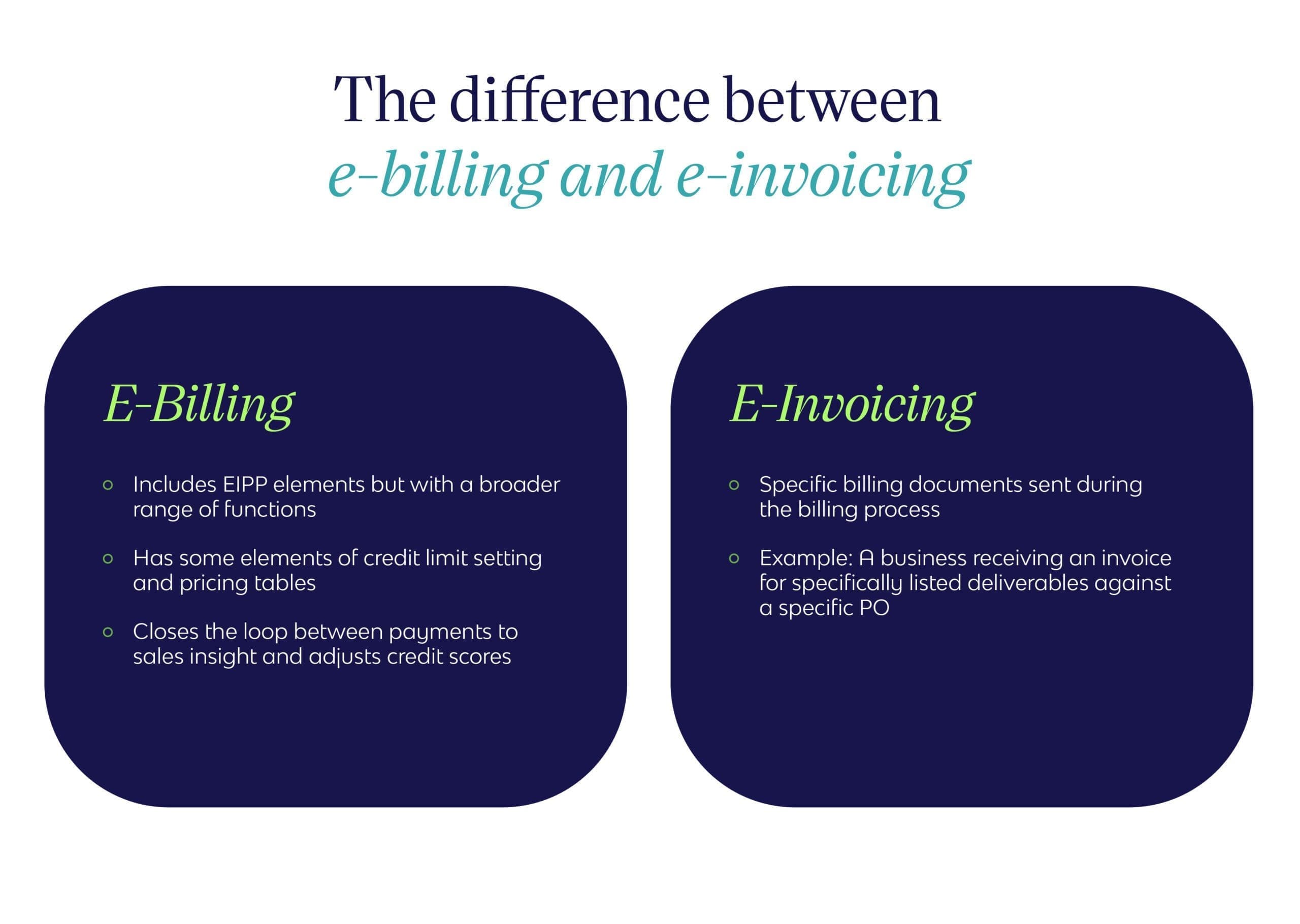Understanding e-billing and e-invoicing: definitions, benefits, and nuances
Corcentric

Electronic bills and invoices are ubiquitous now, and for good reason. It’s time to move away from paper bills, which require printing and delivery by post, and embrace e-billing to achieve more efficient and effective delivery. E-bills can even link directly to FAQs or payment processing, to speed up bill payments.
What is e-billing?
Electronic billing or e-billing is the process by which bills are sent and paid electronically. This process enables customers to receive bills via email, web portal, or even in machine-readable data formats, facilitating more efficient delivery and payment.
The e-billing process is managed by the Accounts Receivable department, taking output from accounting software or ERP systems and delivering this to customers. Increasingly, aspects of this paperless process are automated to improve speed and accuracy, including follow-up actions where bill pay timeframes go beyond terms.
What an e-bill looks like
An e-bill or e-invoice is simply an electronic version of a traditional bill or invoice. Visually, this can mirror a traditional paper bill layout, or leverage online capabilities – such as a direct link to bill payment, FAQs, or associated resources.
Alternatively, e-bills can be delivered as machine-readable data such as EDI or XML format documents to facilitate automatic processing and payment by accounts receivable software.
In a B2B context, e-billing concerns the delivery of electronic invoices which have specific details such as payment timeframe, tax information, PO number, and itemised deliverables.
How the e-billing process works
E-billing is the process by which electronic bills are generated and delivered to customers, reminders sent, and payments collected. The e-billing process also encompasses some degree of pricing and credit setting, which can be manually set for each customer or determined by rules-based automation.
The steps in the e-billing process are listed below.
-
- Credit setting – the first step in any billing process is to determine the credit limit and due date for remittance. Modern e-billing solutions can close the loop from sales to credit setting to optimise performance and minimise risk.
- Pricing – the next step is determining the pricing for goods or services provided. Electronic billing solutions can look up pricing from a database and apply account or contact level discounts as required.
- Bill creation – e-bills are generated from ERP or accounting system data, which is fed into the bill template required for each recipient – from PDF to EDI. This step is normally automated and progresses far faster than traditional manual bill creation.
- Bill delivery – another step which is commonly automated, the delivery of e-bills can progress via email, portal, file transfer, or direct data transmission. Bill notification by SMS, email notification, WhatsApp, or similar channels can be used to alert recipients to their e-bill being available via a secure online portal.
- Reminders – if the biller believes customers have not acknowledged, opened, or paid their e-bill within a specific timeframe, reminder communications can be automatically triggered to encourage prompt payment.
- Payment processing – e-billing offers a distinct advantage over paper billing in receiving payments, because customers can be supplied a link to click and pay their bill online via credit card or direct deposit. Greater automation is possible when e-bills are delivered to automated accounts payable systems which validate the payment request via PO number reference and make automatic payments via ACH/NACHA.
- Sales intelligence and reporting – tracking and reporting on e-bill delivery, receipt, and even who has read or responded to e-bills provides a distinct advantage when tackling late payments for healthy cash flow. Sales insights can be gleaned from what has been invoiced, where and when, as well as understanding which accounts may be struggling to pay on time and pose a future credit risk.
Top benefits of e-billing software
E-billing software enables Accounts Receivable departments to become far more efficient. Removing process inefficiencies saves time and money, as well as ensuring more accurate and faster delivery of invoices to customers for prompt payment. A well deployed electronic billing system is more than just an operational upgrade, it’s a strategic advantage.
Top benefits of e-billing software are:
-
- Process efficiency – paper bills require far more time and effort to produce and deliver. Electronic bills take a fraction of this.
- Improved accuracy – direct connection between an electronic billing system and accounting software and/or ERP systems eliminates human error from the process.
- Enhanced deliverability – sending paper bills, by post, doesn’t guarantee deliverability. The pandemic has shown electronic delivery to be more flexible and accurate, reaching customers where they are, in the format they want.
- Status visibility – knowing who has received, read, and responded to their e-bills enables more targeted follow-up actions and assists cash flow forecasting.
- Automation – businesses are increasingly looking to automate repetitive manual processes for enhanced efficiency, so skilled staff can focus on more profitable activities. The move from paper bills to e-billing presents a massive opportunity for process automation.
- Streamlined bill payments – e-bills can be sent with payment links to take payments online via credit card, debit card, or direct deposit.
- Reduced overheads – not having to maintain and manage the machinery for printing and delivering paper bills, nor pay for postal delivery, can present a considerable cost saving for many businesses.
- Scalability and flexibility – e-billing presents a far more scalable solution than paper billing. Traditionally, if billing volumes increased, there would need to be investment in printing, process management, and delivery. This investment would be redundant and wasted if volumes then decreased. Electronic systems can scale up and down more quickly and efficiently.
- Reduced carbon footprint – paper bills require more energy and resources to produce and deliver (by post). Electronic bills are far more energy efficient and better for the environment.
- Improved customer experience – paper bills may look a little old fashioned to customers now. E-bills can be presented in a more professional manner, with streamlined access and payment processing, simplifying, and enhancing each customer’s experience of your brand.
Who e-billing helps
E-billing helps a wide range of functions within any business. From streamlining bill creation and delivery within accounts receivable, through to automation of your customers’ accounts payable processes. The improvements in working capital and cash flow forecasting provide the assurance and capital to support growth and investment across the business. Some of the biggest impacts are listed below.
-
- Finance – e-billing improves billing efficiency and liberates working capital by driving down DSO previously held up in the receivables ledger. The greater status visibility inherent in e-billing enables more accurate cash flow forecasting, supporting investment across the broader business for growth and stability.
- Customers – when customers receive their bills electronically, they are able to pay them more easily and quickly, as well as having access to billing histories should they need to reprint anything.
- Vendors – if you allow your supply chain to invoice you electronically, they can operate more efficiently and you can make payments more quickly, without losing time to querying and clarifying inaccurate invoice details.
- AR department– accounts receivable benefit from e-billing more than any other aspect of the business. It is here that the benefits of process automation and efficiency improvements enable enhanced performance against KPIs.
- AP department– receiving invoices electronically helps accounts payable to forecast spend, take advantage of early-payment discounts, and process payments more efficiently.
- Operations – operations benefit from the improved cash flow and financial forecasting capabilities e-billing brings, allowing greater investment where it is needed to improve operating capabilities and efficiency.
How is e-billing different than e-invoicing?

Although e-billing and e-invoicing are sometimes used interchangeably, electronic invoicing is more frequently used to describe a specific aspect of the billing process in a B2B context. Consumers receiving a utility bill electronically would tend to describe this as a bill, whereas a business receiving an invoice for specific listed deliverables, against a specific PO, would talk about having received an invoice.
Invoices are specific billing documents sent during the billing process. E-billing tends to encompass a broader range of functions than invoice creation, delivery, follow-up, and payment handling found in EIPP (electronic invoice presentment and payment) or e-invoicing. E-billing also includes some element of credit limit setting and pricing tables, as well as closing the loop from payments to sales insight and adjusting credit scores.
The e-billing system or solution within an organisation will include an EIPP element, but extends this to include insight, pricing, and credit considerations applicable to both account and payer.
Can e-billing and e-invoicing help my organization?
Having read this far, you are likely to be considering an investment in e-billing, perhaps looking to deploy e-billing software in-house or selecting a suitable service provider to ensure your e-billing deployment is a success.
Our advice would be to talk to a few different e-billing providers, who can help you define the solution you need and how to best go about this. At Corcentric, we can help you evaluate various aspects of EIPP and the broader e-billing solution set – get in touch for a no-obligation discovery call today.
You can also take a look at our resources to help evaluate the benefits of deploying e-invoicing in-house vs. outsourcing this to a service provider, or if you’ve decided a service provider is the solution for you, you can use this evaluation check-list to determine whether they cover your requirements.